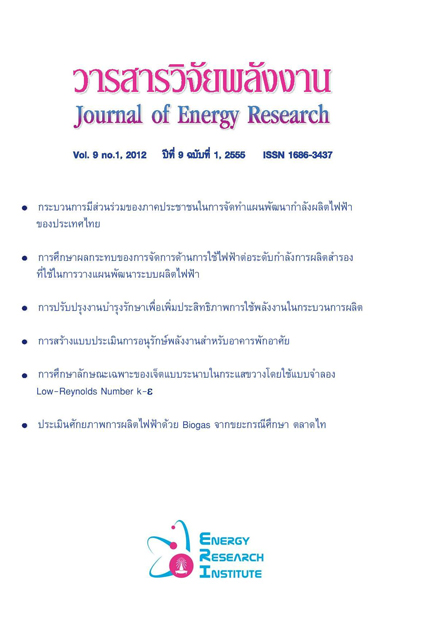ประเมินศักยภาพการผลิตไฟฟ้าด้วย Biogas จากขยะ กรณีศึกษา ตลาดไท
Main Article Content
Abstract
ในปัจจุบันนี้ไม่ว่าเราจะหันไปในทิศทางใดก็ไม่สามารถที่จะปฎิเสธได้ว่าความต้องการทางด้านพลังงานมีเพิ่มสูงขึ้นอยู่ตลอดเวลา ซึ่งหนึ่งในหลายๆพลังงานที่มีความสำคัญเป็นอันดับต้นๆนั่นก็คือพลังงานไฟฟ้า โดยพลังงานไฟฟ้านั้นเป็นที่ต้องการมากขึ้นทั้งในส่วนของภาคครัวเรือน ธุรกิจร้านค้ารายย่อย ตลอดจนถึงภาคอุตสาหกรรม ซึ่งบทความนี้เป็นการศึกษาและการประเมินถึงศักยภาพความเป็นไปได้ในด้านของการเพิ่มความสามารถในการผลิตกระแสไฟฟ้าภายในชุมชน โดยการนำขยะและเศษอินทรีย์สารจากตลาดและขยะภายในชุมชนมาผลิตเป็นก๊าซชีวภาพด้วยเทคโนโลยีการผลิตก๊าซชีวภาพแบบ Dry Fermentation จากนั้นจึงนำก๊าซชีวภาพที่ได้มาเข้าเครื่องกำเนิดพลังงานไฟฟ้าเพื่อผลิตกระแสไฟฟ้าให้กับชุมชนต่อไป โดยผลจากการศึกษาข้อมูลปริมาณขยะในส่วนที่สามารถนำมาผลิตเป็นก๊าซชีวภาพตลอดปี พศ. 2553 พบว่าอัตราเฉลี่ยปริมาณขยะภายในตลาดไท มีค่าเท่ากับ 94.19 ตันต่อวัน ซึ่งจากการศึกษาพบว่าจะสามารถผลิตก๊าซชีวภาพได้ที่ 17,807 ลูกบาศก์เมตรต่อวัน โดยจะสามารถผลิตเป็นพลังงานไฟฟ้าได้อยู่ที่ 12,643 – 24,929 kWh หรือเท่ากับ 0.53 – 1.04 MW (จากการคิดค่าปริมาณก๊าซชีวภาพที่ 1 ลูกบาศก์เมตรต่อ ปริมาณกระแสไฟฟ้าที่ต่ำสุด 0.71 และสูงสุดที่ 1.4 kWh ) ซึ่งจากการคำนวณและประเมิณค่าใช้จ่ายและรายรับจากโครงการแล้วนั้นพบว่า รายจ่ายรวมต่อวันจะอยู่ที่ 12,119 บาท ในขณะที่รายได้ทั้งในส่วนการจำหน่ายไฟฟ้าและขายปุ๋ยที่ได้จากส่วนที่เหลือของกระบวนการการผลิตก๊าซชีวภาพหลังหักรายจ่ายในส่วนต่างๆทั้งหมดออกแล้วกรณีที่ไม่คิด Adder ค่าต่ำสุดจะอยู่ที่ 56,419 บาทต่อวัน และค่าสูงสุดจะอยู่ที่ 89,150 บาทต่อวัน และในกรณีที่คิด Adder ค่าต่ำสุดจะอยู่ 62108 บาทต่อวัน และค่าสูงสุดจะอยู่ที่ 100,369 บาทต่อวัน โดยมีค่า NPV ของโครงการค่าต่ำสุดจะอยู่ที่ 144,561,595 บาท และค่าสูงสุดจะอยู่ที่เท่ากับ 232,162,873 บาท และ IRR ต่ำสุดของโครงการจะเท่ากับร้อยละ 28.93 และสูงสุดที่เท่ากับร้อยละ 48.01
Potential analysis of fresh-food market waste for biogas production to electricity; case study Talad-Thai
Pariphat Chungchaichana1 and Supawat Vivanpatarakij2
1Energy Technology and Management, Graduate School Chulalongkorn University
2Energy Research Institute Phaya Thai Road, Wang Mai, Pathum Wan, Bangkok, Thailand 10330
Nowadays the demand of energy has increased every year. One of several energy is as important as the primary means of electricity. The electrical power is more desirable in the household, small businesses and in the industry. This article study and evaluate the potential of generate electricity within the community. This study uses the garbage and organic waste material from the market to produce biogas by using Dry Fermentation technology. Gas engine generator is used to produce electricity.
The results show the amount of 94.19 ton/day waste can be produce biogas 17,807 m3/day. It can produce electricity at 12,643 - 24,929 kWh, or 0.53 - 1.04 MW (from up to 1 cubic meter of gas per electricity minimum at 0.71 and maximum at 1.4 kWh) from the calculated, the costs and revenues of the project, it was found that expenditure per day is equal to 12,119 baht, and revenue in both the distribution of electricity and sale of fertilizer from the rest of the biogas production after deduction of expenses in all segments, and then if do not included the Adder value, minimum is at 56,419 baht per day and the maximum is at 89,150 baht per day, and if included the Adder value, minimum is at 62,108 baht per day and the maximum is located at 100,369 baht per day, with the NPV of the project is located at the bottom. 144,561,595 baht and maximum values are equal to 232,162,873 baht and IRR of the project will be the lowest and the highest at 28.93 percent, 48.01 percent.
